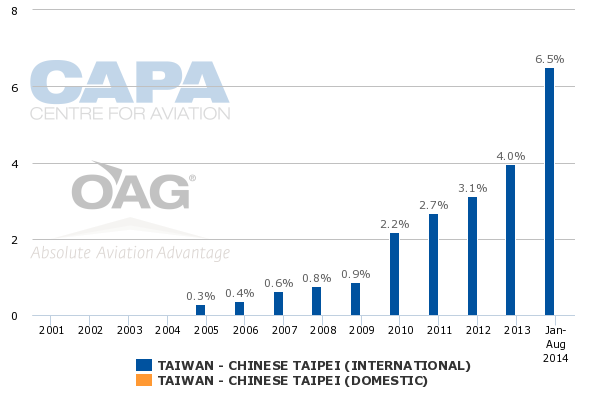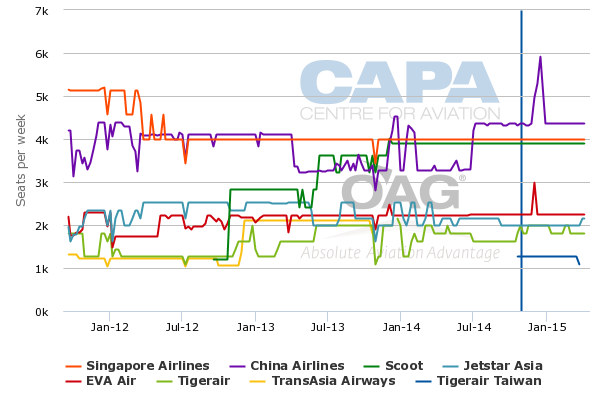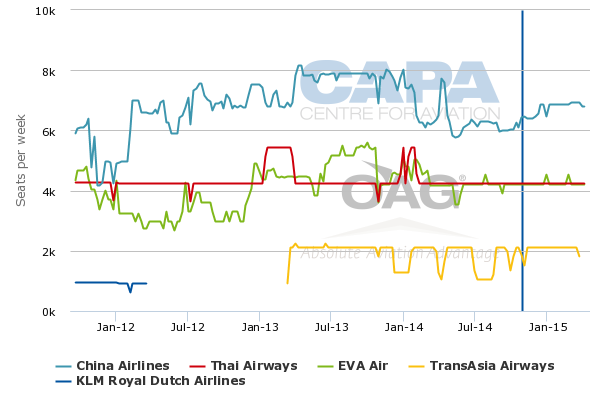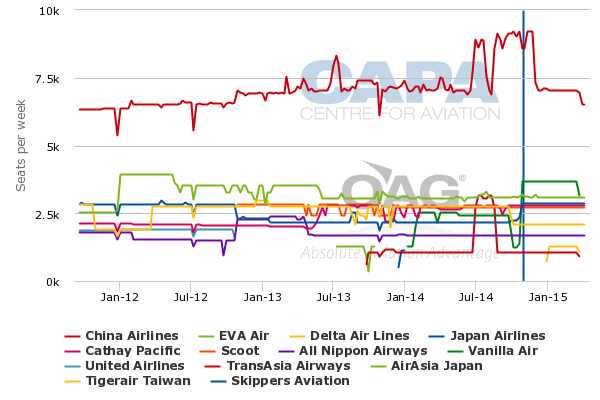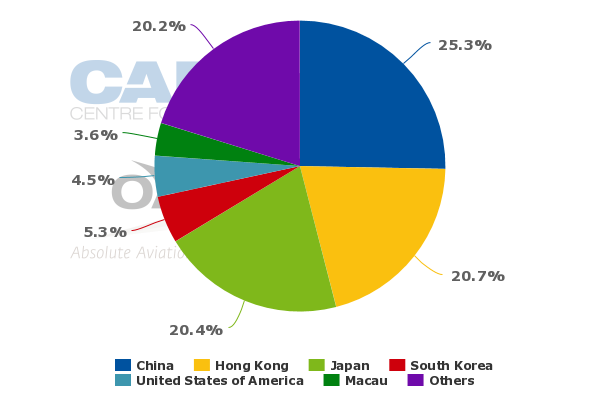New China Airlines subsidiary Tigerair Taiwan eyes rapid expansion after becoming Taiwan’s first LCC
LCC start-up Tigerair Taiwan is planning to pursue rapid expansion with an initial focus on Singapore, Thailand, Japan and South Korea. China could eventually become Tigerair Taiwan's largest market if bilateral restrictions, which are the carrier's biggest obstacle to growth, are eased.
The new China Airlines (CAL) subsidiary became Taiwan's first LCC on 26-Sep-2014, when it launched services to Singapore with one A320. A second A320 will be added in Nov-2014 and used to launch services to Thailand while a third A320 is expected to arrive by early 2015 and support new services to Korea and Japan.
Tigerair Taiwan is encouraged by initial load factors on the Singapore route and moves by the Taiwanese government to liberalise and promote LCC development. It now expects to grow faster than outlined in its initial business plan, which envisioned a fleet of 12 A320s by the end of its third year.
Tigerair Taiwan is a win-win for the Tigerair and China Airlines groups
Tigerair Taiwan is 90% owned by CAL, which is the market leader in Taiwan with about a 31% share of total seat capacity when including its full-service regional subsidiary Mandarin Airlines. The remaining 10% of Tigerair Taiwan is owned by Singapore-listed Tiger Airways Holdings, also known as the Tigerair Group.
The Tigerair Group is now focusing on the Singapore market, having sold its entire stakes in Tigerair Australia and Tigerair Philippines and having shut down its joint venture in Indonesia. The group's investment in Tigerair Taiwan is very small as it needs to focus its resources on turning around its core Singapore operation, which was unprofitable for the fifth consecutive quarter in the three months ending 30-Sep-2014. But Taiwan could become strategically important as Taipei emerges as a second hub for the Tigerair Group, covering North Asian markets that are not within narrowbody range of Singapore.
Meanwhile Tigerair Taiwan is strategically important to CAL as the group's new multi-brand strategy should allow it to maintain and potentially grow its leading position in Taiwan as it starts to participate in the fast growing budget end of the Taiwanese market. Previously only foreign LCCs catered to this segment, accounting for about 7% of total seat capacity in Taiwan.
Taiwan's fragmented market will benefit from higher LCC penetration
Without a budget subsidiary CAL would have risked ceding market share to rival TransAsia, which is preparing to launch its own budget subsidiary V Air by the end of 2014. TransAsia is Taiwan's third largest carrier and currently has about an 8% share of total seat capacity in Taiwan.
EVA Air is the second largest Taiwanese carrier and has a 19% share of capacity or 21% when including its full service subsidiary Uni Airways.
Taiwanese carriers ranked by seat capacity: 27-Oct-2014 to 2-Nov-2014
| Rank | Airline | Total Seats | |
|---|---|---|---|
| 1 | CI | China Airlines | 318,727 |
| 2 | BR | EVA Air | 222,162 |
| 3 | GE | TransAsia Airways | 87,364 |
| 4 | AE | Mandarin Airlines | 40,984 |
| 5 | B7 | Uni Airways | 20,732 |
| 6 | IT | Tigerair Taiwan | 2,520 |
Foreign carriers account for 40% of total seat capacity in Taiwan. This includes about a 33% share from full service carriers and a 7% share from LCCs.
Taiwan top 10 foreign full service carriers ranked by seat capacity: 27-Oct-2014 to 2-Nov-2014
| Rank | Airline | Total Seats | |
|---|---|---|---|
| 1 | CX | Cathay Pacific | 100,258 |
| 2 | KA | Dragonair | 34,100 |
| 3 | MU | China Eastern Airlines | 31,636 |
| 4 | CZ | China Southern Airlines | 26,310 |
| 5 | JL | Japan Airlines | 23,100 |
| 6 | CA | Air China | 22,816 |
| 7 | HX | Hong Kong Airlines | 15,456 |
| 8 | TG | Thai Airways | 12,684 |
| 9 | MF | Xiamen Airlines | 11,900 |
| 10 | VN | Vietnam Airlines | 11,776 |
There are currently 15 LCCs serving Taiwan, 14 foreign carriers and Tigerair Taiwan. Vietnam's VietJet Air will become the 15th foreign LCC serving Taiwan in Dec-2014, when it launches service from Ho Chi Minh to Taipei.
Taiwan LCC capacity by carrier: 27-Oct-2014 to 2-Nov-2014
| Rank | Airline | Total Seats | |
|---|---|---|---|
| 1 | TZ | Scoot | 16,080 |
| 2 | D7 | AirAsia X | 10,556 |
| 3 | MM | Peach | 10,080 |
| 4 | 3K | Jetstar Asia | 7,920 |
| 5 | JW | Vanilla Air | 7,350 |
| 6 | BX | Air Busan | 5,280 |
| 7 | UO | HK Express | 4,872 |
| 8 | TR | Tigerair | 3,960 |
| 9 | 9C | Spring Airlines | 3,960 |
| 10 | 5J | Cebu Pacific Air | 3,580 |
| 11 | AK | AirAsia | 2,520 |
| 12 | IT | Tigerair Taiwan | 2,520 |
| 13 | TW | T'way Air | 1,512 |
| 14 | ZE | Eastar Jet | 990 |
| 15 | 8L | Lucky Air | 328 |
Taiwanese consumers have benefitted from the expansion of foreign LCCs, which has pushed up the LCC penetration rate in Taiwan's international market over the past five years from less than 1% in 2009 to about 7% currently. But the market was clearly overdue for a local LCC, which was necessary for Taiwan to approach the average global LCC penetration rate of 27%.
Taiwan LCC capacity share (% of total seats): 2001 to 8M2014
See related reports:
Taiwan becomes last major Asian market with an LCC
Taiwan was the last of the 12 largest aviation markets in Asia without a local LCC. Taiwan was also the only major Asian country that has not issued a new air operator's certificate in the last decade. Tigerair Taiwan is Taiwan's first new airline in 23 years.
The establishment of LCCs - and the first new airline in over two decades - should further accelerate growth in Taiwan's already hot aviation market. Taiwan has been the fastest growing of the main Asian markets this year with seat capacity growth of nearly 20% year over year. Taipei Taoyuan International Airport recorded 13% passenger growth in 1H2014, making it one of the fastest growing large airports in Asia.
The cross-Straits market between Taiwan and mainland China has driven most of the recent growth. The Taiwan-China market, which was closed to any non-stop flights until 2003 (and until 2006 on a year-round basis), continues to gradually liberalise but at least for the short to medium term it will not be open to Taiwan's new LCC sector.
Taiwanese LCCs will initially focus on Southeast Asia and those North Asia markets that are not bilateral constrained, primarily Japan. The result should be continued growth for full service carriers in the Taiwan-China market, where there is still plenty of room for expansion without low fare stimulation, while the LCCs stimulate growth in other short-haul markets.
In many cases Taiwan's LCCs will serve markets which are already served by foreign LCCs. But there are still plenty of opportunities in most of these markets to stimulate growth through higher LCC penetration rates. LCCs currently only account for 20% of seat capacity between Taiwan and Southeast Asia, 17% in the Taiwan-Korea market and 12% in the Korea-Japan market, based on CAPA and OAG data for the week commencing 27-Oct-2014.
Taipei-Singapore was logical first route for Tigerair Taiwan
Singapore, Tigerair Taiwan's first route, already had a relatively high LCC penetration rate of about 40%. But Tigerair Taiwan has seen buoyant demand and high initial load factors.
Tigerair Taiwan CEO Kwan Yue told the CAPA Aviation Summit and LCC Congress on 13-Oct-2014 that the airline has had a "very encouraging start". In a following interview with CAPA TV Mr Kwan reiterated that "we are very encouraged by the load factors".
Tigerair Taiwan CEO Kwan Yue discusses how the Taiwanese have responded to the country's first LCC and the carrier's plans for network and fleet growth
Tigerair Taiwan's relationship with Tigerair Singapore has clearly helped its performance on the Taipei-Singapore route. While it does not yet offer connections beyond Singapore, Tigerair Taiwan uses the Tigerair website and is able to leverage the well established Tigerair brand for Singapore point of sales.
The Tigerair Taiwan flights to Singapore are designed to complement Tigerair Singapore's Taipei schedule. Tigerair Taiwan is operating its Taipei-Singapore flight in the morning while Tigerair Singapore has afternoon and evening departures from Taipei. From Singapore, Tigerair Taiwan has an afternoon departure while most of Tigerair Singapore's departures are in the morning. (Two days of the week there is overlap between the two Tigerair carriers on the Singapore-Taipei leg.)
Tigerair Singapore currently has 10 weekly frequencies to Taipei with Tigerair Taiwan providing an additional seven frequencies. Rival Jetstar Asia has 11 weekly frequencies and Tigerair partner Scoot operates 10 weekly flights.
Scoot uses much larger aircraft than the other LCCs on the Singapore-Taipei route, 402-seat 777-200s. But not all of Scoot's capacity is allocated to the local market as seven of Scoot's Taipei flights continue to Tokyo Narita and three to Seoul Incheon.
Taipei to Singapore capacity by carrier (one-way seats per week): 19-Sep-2011 to 12-Apr-2015
LCCs now account for about 47% of capacity on the Taipei-Singapore route with the remaining 53% split between CAL with about 22%, Singapore Airlines with 20% and EVA with 11%. All three FSCs use widebody aircraft on the route, with CAL and SIA operating two daily flights and EVA one daily flight. TransAsia exited the Singapore market in Sep-2013 after slightly over two years on the route trying various schedule and aircraft (narrowbody and widebody) combinations.
The early success of Tigerair Taiwan's Singapore route indicates the Taiwanese market is ripe for more LCC capacity. TransAsia's inability to succeed on the route highlights the challenges facing FSC new entrants in established markets. TransAsia could potentially take another stab at the Taipei-Singapore market using V Air.
Tigerair to launch services to Thailand in mid Nov-2014
Tigerair Taiwan's second market will be Thailand, which will be added in Nov-2014 after the carrier takes delivery of its second A320. Daily service from Taipei to Bangkok Don Mueang will begin on 14-Nov-2014 and four weekly flights from Taipei to Chiang Mai in northern Thailand will be launched on 15-Nov-2014.
Tigerair Taiwan will become the first LCC in the Taiwan-Thailand market. Currently CAL, EVA Air, TransAsia and Thai Airways operate a combined 66 weekly frequencies from Taipei to Bangkok Suvarnabhumi, primarily with widebody aircraft.
Taipei to Bangkok Suvarnabhumi capacity by carrier: (one-way seats per week): 19-Sep-2011 to 12-Apr-2015
Tigerair Taiwan will be the first airline to link Taipei with Don Mueang, Bangkok's old closer-in airport which is now used by all Thailand-based LCCs. Tigerair Taiwan has elected against following sister carrier Tigerair Singapore in using Suvarnabhumi. Mr Kwan told CAPA that while Tigerair Taiwan uses Tigerair's website and there are other potential synergies the carrier does not see the benefit of leveraging the group's relationships with airports or ground handling suppliers.
Tigerair Taiwan will instead seek to negotiate its own contracts with airports and suppliers. Mr Kwan said network decisions are also being made completely independently of its two shareholders. Although CAL has a powerful 90% stake it has given Tigerair Taiwan's management team complete freedom on what routes to pursue.
AirAsia does not yet serve Thailand-Taiwan market
It is hardly a surprise that V Air also has identified Bangkok as its first route, with services expected to begin by the end of 2014. Taipei-Bangkok is a large market consisting mainly of leisure passengers. The demographic of the market and the length of route, which is slightly under four hours, makes it ideal for LCCs.
Thai AirAsia surprisingly has not yet entered the Taiwanese market. Tigerair Taiwan and V Air are smart to make a move now and beat AirAsia to the punch.
AirAsia is the second largest LCC brand in the Taiwanese market (after Scoot) and currently offers two daily flights from Kuala Lumpur to Taipei using A330s operated by AirAsia X as well as one daily flight from Kota Kinabalu to Taipei using A320s operated by Malaysia AirAsia. (Taipei-Kuala Lumpur is about four and a half hours, making it a route for AirAsia X rather than Malaysia AirAsia but Taipei-Kota Kinabalu is only about three hours. As Taipei-Bangkok is less than four hours it would be a route for Thai AirAsia rather than long-haul LCC start-up Thai AirAsia X.)
AirAsia's strong presence in the Taipei-Kuala Lumpur market could make it challenging for Taiwanese LCCs to enter the Malaysian market. AirAsia X also has had success in several one-stop markets from Taiwan, including to other destinations in Southeast Asia and to Australia, as it has taken advantage of the relative lack of LCC options from Taipei.
Tigerair Taiwan for now does not offer connections or codeshares/interlines
Tigerair Taiwan could ultimately serve several of the one-stop markets being targeted by AirAsia with non-stop flights as well as offer competing one-stop options to destinations such as Australia. The one-stop options would require a connecting product with Tigerair Singapore and Scoot. For now Tigerair Taiwan does not offer a connection product but plans to look at offering connections in Singapore and introducing the TigerConnect product in Taipei at a later phase.
Tigerair Taiwan is also open to looking at codesharing or interlining with CAL and potentially other carriers at a later phase but for now is following a point to point model. A relationship with CAL would particularly be sensible on routes that are not already served by CAL such as Taipei-Chiang Mai.
Taipei-Chiang Mai is a smaller route that is currently only served by TransAsia with two weekly narrowbody frequencies. Chiang Mai is a growing leisure market that has become popular with Chinese and Taiwanese. But there is a risk of overcapacity as both Tigerair and V Air plan to serve the route.
Tigerair Taiwan aims to serve Korea in Japan by early 2014
Mr Kwan told CAPA TV that Tigerair Taiwan plans to add South Korea and Japan once its third A320 is delivered. "That should all come about very quickly, within the next few months," he said.
Since speaking to CAPA TV Tigerair Taiwan has filed three proposed routes to Korea and Japan - Taipei-Jeju, Taipei-Tokyo Narita and Kaohsiung-Tokyo Narita. The carrier has proposed starting service to Korea's Jeju Island on 7-Dec-2014 with four weekly flights while both Tokyo routes are planned as daily services from 1-Jan-2015. (Tigerair Taiwan has not yet begun ticket sales on any of these routes but recently began selling flights to Bangkok and Chiang Mai.)
Taipei-Jeju is only currently served by TransAsia with two weekly flights, according to OAG data. Narita is Taipei's second largest international market after Hong Kong and is Kaohsiung's third largest international market after Hong Kong and Macau, based on current set capacity.
Kaohsiung, which is Taiwan's second largest city, is currently linked with Narita by CAL, EVA and Japan Airlines with one daily flight operated by each carrier. Taipei Taoyuan-Narita is served with almost 130 weekly return flights operated by nine carriers. CAL is already the market leader with a 30% share of seat capacity between Taipei and Narita.
Taipei to Tokyo Narita capacity by carrier: (one-way seats per week): 19-Sep-2011 to 12-Apr-2015
There are also 56 weekly return flights by four carriers between Tokyo Haneda and Taipei's second closer-in airport, Songshan. There are no services between Songshan and Narita.
Of the nine carriers currently operating the Taipei-Tokyo Narita route, only two are LCCs - Scoot and Vanilla Air. The route is ripe for more LCC capacity given the current LCC penetration rate is only 21%.
Scoot's decision in 2012 to take advantage of fifth freedom rights available to Singaporean carriers on Taipei-Tokyo highlights how the market is relatively underserved. Jetstar Asia has used similar rights to compete in the Taipei-Osaka market, which it now serves with 11 weekly frequencies.
Constrained bilaterals limit Tigerair Taiwan's options
Taiwan and Japan have a liberal air services agreement, opening up the opportunity for significant LCC expansion. Taiwan also has liberal agreements with most Southeast Asian countries.
But North Asian markets other than Japan have limitations. This includes Hong Kong and mainland China, which are the two largest international markets from Taiwan and combined account for nearly half of total international seat capacity from Taiwan.
Taiwan international capacity share by country/territory: 28-Oct-2014 to 2-Nov-2014
Japan is Taiwan's third largest international market while South Korea is fourth largest. Secondary markets in South Korea including Jeju are open for new flights from Taiwanese carriers but Seoul is capped.
Jeju Air for example has been unable to get traffic rights for Seoul-Taipei, a large and potentially lucrative market which is not currently served by any LCCs except Singapore-based Scoot. The ability of Scoot to enter this market and for Cathay Pacific and Thai Airways to also serve the route with fifth freedom rights has frustrated Jeju Air. Asiana, Korean Air, CAL and EVA also operate the route using all the available traffic rights for Korean and Taiwanese carriers.
Mr Kwan told the CAPA Summit that bilateral constraints "is one of the biggest challenges facing us right now". For now the restricted air service agreements clearly favour the incumbent full service carriers.
But Mr Kwan is confident the Taiwan market will liberalise, pointing out that the Taiwanese government is encouraging LCC development and is holding bilateral discussions with several countries aimed at securing traffic rights for Taiwan's two new LCCs. "We are positioning ourselves more for the long-term growth and to be in the position to take on all the opportunities as they come along. We believe that will be better over time definitely," Mr Kwan said.
Tigerair could use Taipei as hub for North Asia
Mr Kwan added that Tigerair Taiwan sees mainland China as "potentially the biggest market for us". If restrictions are eased, Taiwan's LCCs could operate several routes to mainland China.
While there is a huge and still under-served local market between Taiwan and China, Tigerair Taiwan also sees the potential of Taipei becoming an LCC hub to connect Southeast Asia with China and the rest of North Asia. Mr Kwan points out that Taipei is within narrowbody range of all of China, Korea and Japan while from Singapore only part of China is within narrowbody range.
Mainland China is an important market for Tigerair Singapore and the carrier continues to grow its Chinese network even as it cuts back elsewhere. In Nov-2014 Tigerair Singapore is launching services to Guilin and Nanning, giving it nine destinations in mainland China. But there are still dozens of secondary cities in other parts of China which Tigerair Taiwan could potentially serve from Taipei, enabling the Tigerair Group to further expand its presence in the Chinese market. (Tigerair also has access to Scoot's four Chinese destinations but while Scoot also plans to expand its network in China there are several secondary destinations that cannot be viably served non-stop from Singapore.)
Mr Kwan is confident Tigerair Taiwan can grow rapidly and capture a majority of the Taiwanese LCC market. Tigerair Taiwan's initial business plan envisions a fleet of 12 aircraft by Sep-2017. But Mr Kwan said in the CAPA TV interview that "we will actually grow to the 12 aircraft well within the three years. That's what we are looking forward to".
Tigerair Taiwan sources initial fleet from Tigerair Group
Tigerair Taiwan's first aircraft came from the Tigerair Group order book and is owned by Tigerair Taiwan, fulfilling a Taiwanese requirement for airlines to have at least one owned aircraft. The aircraft now in operation at Tigerair Taiwan was the final A320ceo taken by the Tigerair Group, which in Mar-2014 announced it was cancelling its last nine A320ceo orders as part of a deal for 35 A320neos which will be delivered from 2018.
See related report: Tigerair cancels nine A320s - averting excessive capacity in the Singapore market
The Tigerair Group initially indicated Tigerair Taiwan was not planning to source additional aircraft from the group and Tigerair Taiwan has not yet identified the source of its second and third aircraft. But a Tigerair source tells CAPA that the second and third A320 for Tigerair Taiwan will now be subleased from the group.
Tigerair recently concluded an agreement to sublease 12 excess A320s to India's IndiGo and has said it is looking to sublease another two to four aircraft. By subleasing 12 A320s to IndiGo and now two A320s to Tigerair Taiwan the group will finally be able to resolve its excess aircraft issue, which emerged earlier this year as 14 aircraft were returned to the group from its previous affiliates in Indonesia and the Philippines. Tigerair Singapore will still have two grounded A319 but is now planning to put these aircraft back into service as 14 of its A320s are moved to India and Taiwan.
Tigerair Group and CAL should be able to reap rewards from Tigerair Taiwan
The launch of Tigerair Taiwan and the placement of three aircraft at the start-up should bring to a close a very difficult chapter for the Tigerair Group. The group has been stung by unsuccessful joint ventures in other Southeast Asian markets and is now eager to focus on its original home market of Singapore with a manageable fleet of about 25 aircraft.
Taiwan has the potential of turning into a more successful yet small investment for the Tigerair Group. Unlike the other overseas markets it has entered (and now exited), Taiwan is underpenetrated by LCCs and Tigerair Taiwan will enjoy first mover advantage. Taiwan is also better positioned than other Southeast Asian countries to serve as a second hub for the Tigerair brand as Taipei can be used to open up connections throughout North Asia.
With its 90% share, CAL stands to benefit even more if Tigerair Taiwan succeeds. After Taiwan decided last year to open up and encourage home-grown LCCs, CAL wisely recognised the need to quickly establish an LCC subsidiary. In nearly every Asian market that has so far opened up to LCCs, first mover advantage has proven to be extremely valuable.
EVA so far has resisted in joining Taiwan's new LCC movement by establishing its own LCC subsidiary. But the pressure for EVA to make a move will inevitably mount as Tigerair Taiwan and V Air quickly expand.
Establishing an LCC subsidiary has become a common strategy at full service airline groups not only in Taiwan but throughout Asia-Pacific. With the launch of Tigerair Taiwan and soon V Air, there will be almost 20 FSC group in the region with an LCC subsidiary or affiliate (see background information).
Full service airlines without an LCC play are now in the minority. EVA and the others in the minority will undoubtedly need to look closely - and quickly - at the multi-brand strategy.
Background information
LCC subsidiaries and affiliates of Asia-Pacific full service airline groups: end 2014
